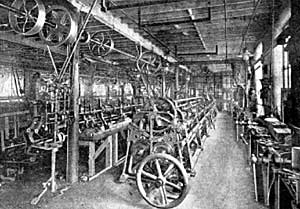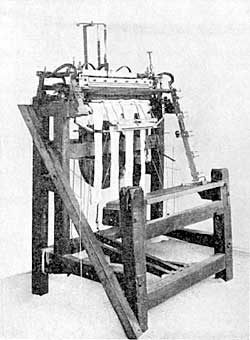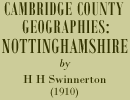< Previous | Contents | Next >
13. Industries.
From the two preceding chapters it will be gathered that agriculture is the main industry for the greater part of the county.
North of the Trent and west of the line joining Nottingham to Mansfield there is a dense population engaged in mining and manufacturing industries. The manufacturing population is concentrated mainly in the city and suburbs of Nottingham, for it is a great commercial convenience to have the factories close together. The mining population is scattered about in straggling towns and villages, for of necessity the mines must be far apart. The importance of coal-mining in the county may be judged by the fact that in 1908 it employed close upon 37,000 men. But more will be said about it under the heading of Mines and Minerals.
The staple manufactures of the county are lace and hosiery.
Nottingham is the metropolis of the lace-making industry. Of the 25,000 people so engaged the great majority are women, and more than four-fifths are in this city. The industry has many branches. At the outset it calls for highly skilled and trained designers, for the sale of the lace depends largely upon the attractiveness of its design. One or several machines are set to manufacture one design until it has gone out of fashion. Sometimes the “run” is only for a few weeks. Occasionally it goes on for several years.
A fancy lace does not come from the machine in single narrow strips as it is sold. A great many strips are made at once side by side. Their edges are held together by long threads running their whole length and they thus form a great sheet—a “piece” as it is termed—many yards long and several wide. The width of the piece, and therefore the number of strips in it, depends upon the length of the machine. In the earliest this was only 18 inches. In the newest, driven by steam or electric motor, it is as much as seven or eight yards.

Typical Nottingham Lace.
Whilst the lace is in the piece it is bleached, dyed, and finished. After this the strips have still to be set free one from another by drawing out the long threads. There are also numerous threads covering the lace which must be clipped away. Sometimes clipping frames are used, but both pieces of work are done mainly by hand and find employment for thousands of people in their own homes. It is a familiar sight in the side streets of Nottingham to see women sitting at the open door on a warm summer’s day drawing, clipping, and scalloping lace.
The main divisions of the lace-trade are edgings, insertions, curtains and nets, plain nets, and warp laces.
From Nottingham and the neighbourhood lace is sent to all parts of the world, more especially to the United States and South America. Large shipments are also made to all parts of Europe and the British colonies. The lace industry is the child of the hosiery industry, but in Nottingham the child has quite outgrown its mother.

Plain Net and Curtain Machines in course of erection.
The hosiery industry is not so concentrated as the lace. About 6ooo hands are employed by it in the city, and over 5000 in the neighbouring towns and villages, such as Mansfield, Arnold, Beeston, Hucknall Torkard, Ruddington, etc.
Until the sixteenth century every family made its own hose. In 1589 the Rev. William Lee of Calverton, near to Nottingham, invented a machine for making stockings. The story of his struggles should be familiar to every boy and girl. This machine came to be called the stocking-frame and could be driven and worked by one man. In the early part of the seventeenth century frame-knitters were proud of their profession and wore a silver knitting-needle as their badge. As the demand for machine-made stockings increased the industry spread to most of the villages of this county and the adjoining parts of Derbyshire and Leicestershire. When water—, and afterwards, steam-power were introduced it became possible to make and work larger and more complex machines for the manufacture not only of stockings but of many other kinds of hosiery. Naturally the hand-frame workers of the villages were placed at a disadvantage and the industry became concentrated in the towns, especially Leicester, Derby, and Nottingham. Throughout the neighbouring parts of the three counties the wide windows in the top stories of many of the houses tell of the times when this village industry flourished unrivalled. Even to-day in some villages, e.g. Calverton, Burton Joyce, etc., the zzit, zzit, zzit, of the stocking-frames announces the fact that they are still used to a limited extent in the manufacture of various kinds of hosiery.

Old Stocking Frame.
For many centuries Nottingham was noted for its smiths. Evidence of their former importance is still forthcoming in the names of many of the streets. The iron for their work was obtained from Pleasley and Bulwell, where the ore from Derbyshire was smelted with the wood from Sherwood Forest. In those days the smiths were engaged in the making of parts of harness and of agricultural implements. In the seventeenth and eighteenth centuries their skill was turned to the making and improving of the stocking-frame. Today it shows itself in the complicated machines required for producing lace and hosiery, and to a less extent, in many other kinds of machinery. The most modern development of this class of work is seen in the growth of the cycle and motor industries.
Side by side with the smithy work flourished the leather-tanning industry. This owed its importance largely to the natural advantage of an abundant supply of bark from the neighbouring forest. This industry is still carried on, but not to the same extent.
Though it does not employ many people the colour-printing done in Nottingham nevertheless stands in the front rank of that class of work in the United Kingdom.
It has been already noticed that the lace and hosiery industries employ a great many women. There are several other important industries which do likewise, e.g. tobacco and cigar-making, laundry work, the “makingup trade” or the making of blouses, skirts, aprons, costumes, and the like.
The importance of Nottingham tends to overshadow the smaller industrial centres in the county. Foremost among these is Newark, which has long been an important brewing, malting, flour-milling, and agricultural-engineering town. Other centres are Mansfield, Sutton-in-Ashfield, Hucknall Torkard, Southwell, Retford, Worksop, and West Stockwith.
